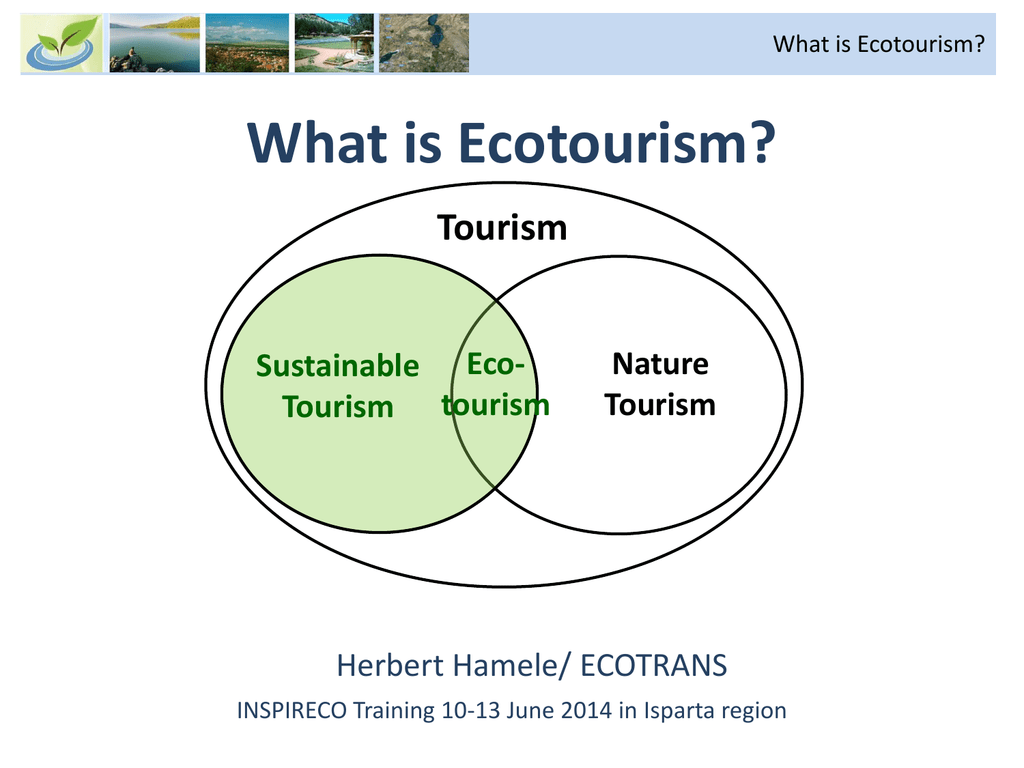Conservation tourism definition is a form of tourism that focuses on preserving and protecting natural and cultural heritage while providing economic benefits to local communities. It offers a unique way to travel responsibly, support conservation efforts, and foster environmental awareness.
Conservation tourism initiatives range from wildlife safaris to ecotourism projects, all aimed at protecting biodiversity, promoting sustainable practices, and generating revenue for local economies.
Definition of Conservation Tourism: Conservation Tourism Definition
Conservation tourism refers to a sustainable form of tourism that prioritizes the preservation and protection of natural and cultural heritage while providing economic benefits to local communities.
Unlike conventional tourism, conservation tourism is characterized by its emphasis on responsible travel practices that minimize environmental impact and support conservation efforts.
Objectives of Conservation Tourism
- Protecting biodiversity and natural ecosystems
- Supporting sustainable development and economic empowerment of local communities
- Promoting environmental education and awareness
- Preserving cultural heritage and traditions
Examples of Conservation Tourism Initiatives
- Wildlife safaris in Africa:Generating revenue for conservation efforts while providing employment opportunities for local communities.
- Ecotourism in the Amazon rainforest:Protecting biodiversity and supporting sustainable livelihoods for indigenous communities.
- Cultural immersion programs in indigenous communities:Preserving cultural traditions and promoting cross-cultural understanding.
Benefits of Conservation Tourism

Conservation tourism offers a wide range of benefits, encompassing economic, environmental, and socio-cultural aspects.
Economic Benefits
Conservation tourism can provide significant economic benefits for local communities and economies. By attracting tourists to protected areas, conservation tourism creates job opportunities in tourism-related sectors such as hospitality, guiding, and transportation. It also stimulates local businesses, such as restaurants, shops, and handicrafts, and supports the development of infrastructure, such as roads, accommodations, and communication networks.
In addition, conservation tourism can generate revenue through park entrance fees, concession agreements, and other tourism-related activities, which can be used to support conservation efforts and community development projects.
Environmental Benefits, Conservation tourism definition
Conservation tourism plays a vital role in protecting biodiversity and ecosystems. By raising awareness of conservation issues, conservation tourism encourages tourists to adopt responsible travel practices that minimize their impact on the environment. It also provides financial incentives for local communities to conserve natural resources and protect wildlife habitats.
Additionally, conservation tourism can support scientific research and monitoring programs, which contribute to a better understanding of ecosystems and the development of effective conservation strategies.
Socio-Cultural Benefits
Conservation tourism can contribute to social and cultural development in local communities. By promoting cultural heritage and traditional practices, conservation tourism can help to preserve and revitalize local cultures. It can also foster cross-cultural exchange between tourists and local people, leading to a better understanding and appreciation of different cultures.
Furthermore, conservation tourism can empower local communities by giving them a voice in the management of their natural resources and cultural heritage.
Challenges of Conservation Tourism
While conservation tourism offers many benefits, it also presents challenges that must be addressed to ensure its effectiveness and sustainability.
Potential Negative Impacts on Local Communities
Conservation tourism can lead to negative impacts on local communities, including:
- Displacement: Tourism development can lead to the displacement of local communities from their traditional lands or livelihoods.
- Economic inequality: Tourism revenue may not be evenly distributed, leading to economic disparities between local communities and tourism operators.
- Cultural erosion: Tourism can lead to the erosion of local cultures and traditions as they adapt to the demands of tourists.
Potential Negative Impacts on Ecosystems
Conservation tourism can also have negative impacts on ecosystems, including:
- Habitat degradation: Tourism activities can damage or destroy natural habitats, leading to the loss of biodiversity.
- Wildlife disturbance: Tourism can disrupt wildlife behavior, such as breeding, feeding, and migration patterns.
- Pollution: Tourism activities can generate waste, noise, and air pollution, which can harm ecosystems.
Recommendations for Mitigating Negative Impacts
To mitigate the negative impacts of conservation tourism, the following recommendations should be considered:
- Involve local communities: Engage local communities in the planning and management of tourism activities to ensure their needs and concerns are met.
- Promote sustainable tourism practices: Implement measures to reduce the environmental impact of tourism, such as using renewable energy, recycling, and minimizing waste.
- Monitor and evaluate impacts: Regularly monitor the impacts of tourism on local communities and ecosystems and adjust management practices accordingly.
Best Practices for Conservation Tourism

To ensure that conservation tourism is truly sustainable, it is essential to follow best practices in planning and management. These practices include:
Involving local communities in the planning and operation of tourism activities to ensure that they benefit from tourism and have a say in how it is managed.
- Minimizing the environmental impact of tourism activities by using sustainable practices such as energy-efficient lighting, water conservation, and waste reduction.
- Educating tourists about the importance of conservation and the role they can play in protecting the environment.
- Supporting local businesses and using local products and services to create economic benefits for the local community.
- Monitoring the impact of tourism on the environment and local communities and making adjustments as needed to ensure that tourism is sustainable in the long term.
Ethical Guidelines for Conservation Tourism Operators
In addition to following best practices, conservation tourism operators should also adhere to ethical guidelines. These guidelines include:
- Respecting the rights of local communities and indigenous peoples.
- Protecting the environment and wildlife.
- Providing accurate information to tourists about the impact of their travel.
- Ensuring that tourism benefits the local community.
- Being transparent about their operations and their commitment to sustainability.
Sustainable vs. Unsustainable Conservation Tourism Practices
The following table compares sustainable and unsustainable conservation tourism practices:
| Sustainable Practices | Unsustainable Practices |
|---|---|
| Involve local communities in planning and operation | Exclude local communities from decision-making |
| Minimize environmental impact | Damage the environment through pollution, deforestation, or over-use of resources |
| Educate tourists about conservation | Fail to educate tourists about the importance of conservation |
| Support local businesses | Use imported goods and services |
| Monitor impact and make adjustments | Fail to monitor impact or make necessary adjustments |
Case Studies of Conservation Tourism
Conservation tourism projects have achieved success in various locations around the world, contributing to the protection of biodiversity and local communities. Here are a few notable case studies and an analysis of their contributing factors:
The Maasai Mara National Reserve, Kenya
- Established in 1961, the Maasai Mara National Reserve is renowned for its abundant wildlife, including the annual wildebeest migration.
- Tourism revenue has provided incentives for local communities to conserve wildlife and their habitats.
- The reserve has implemented community-based tourism initiatives, allowing the Maasai people to benefit economically from tourism while preserving their cultural heritage.
The Galápagos Islands, Ecuador
- Declared a UNESCO World Heritage Site in 1978, the Galápagos Islands are home to unique and fragile ecosystems.
- Strict regulations and controlled tourism have helped preserve the islands’ biodiversity and iconic wildlife, such as giant tortoises and marine iguanas.
- Tourism revenue has supported conservation efforts, research, and education programs.
The Great Barrier Reef, Australia
- The Great Barrier Reef is the world’s largest coral reef system, supporting a vast array of marine life.
- Tourism has generated revenue for conservation efforts, including coral restoration and pollution control.
- The reef’s tourism industry has created employment opportunities for local communities, promoting sustainable practices.
These case studies demonstrate the potential of conservation tourism to support biodiversity conservation, generate economic benefits for local communities, and promote sustainable practices. By carefully managing tourism activities and engaging local communities, conservation tourism can contribute to the long-term protection of natural ecosystems.
Future of Conservation Tourism

Conservation tourism is poised for continued growth and innovation in the years to come. As the world becomes increasingly aware of the importance of protecting the environment, more and more people are seeking out travel experiences that allow them to make a positive impact.
This trend is expected to continue, with conservation tourism becoming an increasingly mainstream form of travel.One of the most important trends in conservation tourism is the growing use of technology to enhance the visitor experience. This includes the use of virtual reality and augmented reality to create immersive experiences that allow visitors to learn about and interact with wildlife without disturbing them.
Technology is also being used to develop new ways to monitor and protect wildlife, and to track the impact of tourism on the environment.Another important trend is the growing emphasis on community-based tourism. This approach to tourism involves working with local communities to develop and manage tourism experiences that benefit both the community and the environment.
Community-based tourism can help to create jobs, support local businesses, and promote cultural understanding.
Collaboration and Partnerships
The future of conservation tourism will also be shaped by collaboration and partnerships between different stakeholders. This includes partnerships between governments, conservation organizations, tour operators, and local communities. By working together, these stakeholders can develop and implement sustainable tourism practices that protect the environment and benefit local communities.
Final Summary
Conservation tourism holds immense potential for sustainable development, promoting economic growth, protecting ecosystems, and empowering local communities. By embracing responsible practices and ethical guidelines, we can harness the power of tourism to conserve our planet and create a brighter future for all.
Top FAQs
What is the main objective of conservation tourism?
Conservation tourism aims to protect and preserve natural and cultural heritage while generating economic benefits for local communities.
How does conservation tourism contribute to environmental conservation?
Conservation tourism supports biodiversity conservation, protects ecosystems, and promotes sustainable practices.
What are the economic benefits of conservation tourism?
Conservation tourism creates jobs, generates revenue for local businesses, and contributes to sustainable economic growth.
